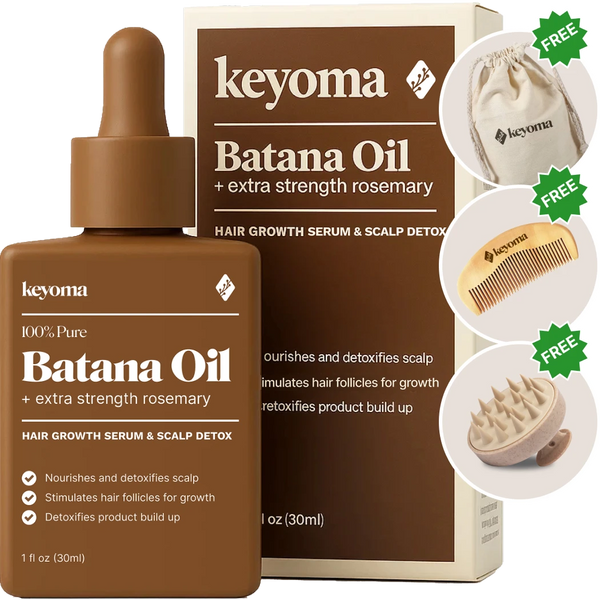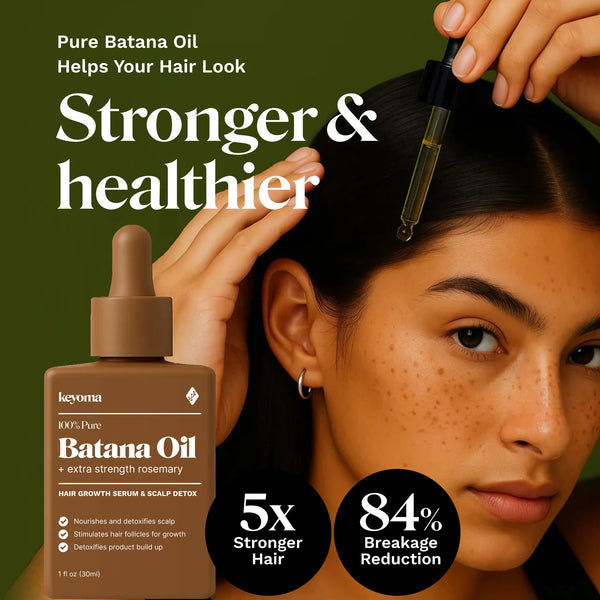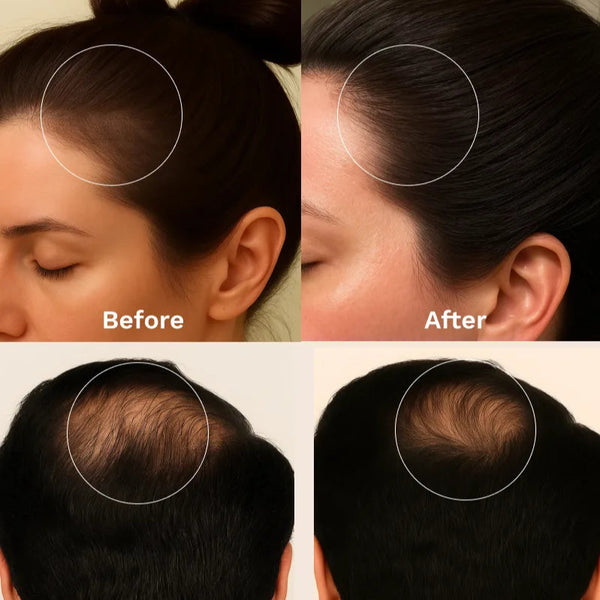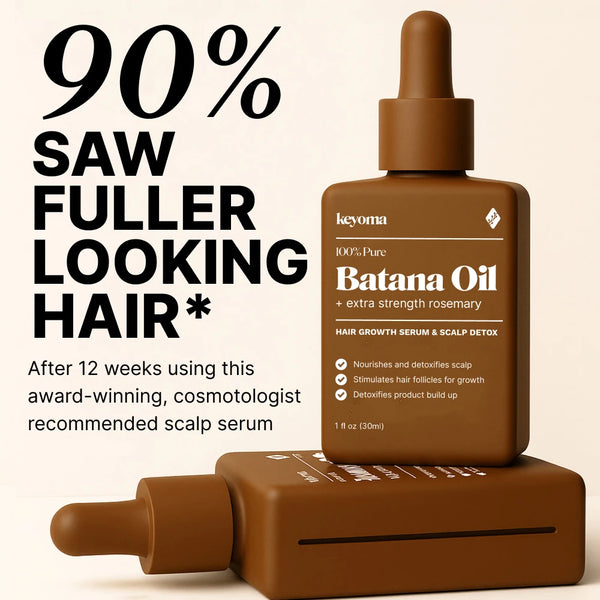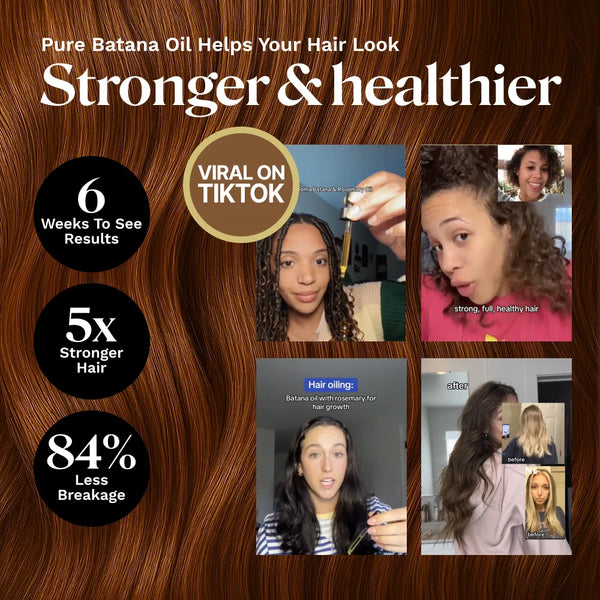In this article
The cosmetic procedure called “microneedling” has made waves in beauty as a restorative skin option. It uses tiny needles to create small punctures that trigger a healing response, boosting collagen so skin looks smoother and feels firmer.
Those same rejuvenating effects now apply to the scalp. Scalp microneedling to support hair growth has become more common and may help people with progressive hair loss like androgenic alopecia (male pattern baldness), which affects both men and women.
“Male pattern baldness” results from genetic and hormonal influences. Many women notice hormonally driven thinning in perimenopause as estrogen drops, sometimes starting in their 40’s. Genetic hair loss is hard to manage, but studies suggest microneedling can help, and many people report seeing benefits.
Key Takeaways
-
Microneedling creates micro-injuries on the scalp, triggering healing and supporting hair regrowth.
-
It can enhance absorption of treatments like batana oil and rosemary, minoxidil, corticosteroids, and platelet-rich plasma.
-
Evidence suggests benefits for androgenic alopecia and alopecia areata, though responses vary.
-
Side effects include redness, swelling, pain, infection risk, scarring, and higher concern with pregnancy and diabetes.
What Is Microneedling?
Microneedling for hair loss, also called microneedle therapy or a microneedle roller treatment, uses very small needles to make micro-injuries in the scalp. It’s done much like facial microneedling, with a trained provider using tools such as skin rollers or derma rollers to create tiny punctures.
These microscopic breaks aim to activate your body’s natural repair process. The micro-injuries can spur collagen and elastin in the scalp, two proteins that support hair growth and overall skin health. The channels made during treatment may also let topical treatments and serums sink in more efficiently, which can improve hair regrowth results.
How Microneedling Works
During a session, your provider rolls a needle-covered device across the scalp.
Needles can range from under 1 millimeter to a few millimeters long, all set within a handheld tool. This roller moves over the target area to create tiny injuries.
Some speculate that microneedling may trigger factors that promote hair growth, or directly stimulate it through controlled injury.
Your provider will apply a topical anesthetic about 45 minutes before starting to help reduce any pain you might feel.
Procedure time varies with the size of the area, but it usually takes under 10 minutes. After scalp microneedling, your provider may smooth on a topical balm or give an injection, depending on the goal of that session.
Benefits of Microneedling for Hair Loss
Microneedling first became known in the 1990s for treating scars. Since that time, it’s been explored as an alternative or add-on option for androgenic alopecia and alopecia areata.
Beyond collagen production in the skin, which may be one reason it helps with acne scars, researchers think microneedling could also help activate stem cells within hair follicles that might encourage growth.
Microneedling may also boost how well products used for hair loss are absorbed, including:
-
Minoxidil
-
Topical steroid
-
Platelet-rich plasma
One study specifically looked at microneedling used with a topical corticosteroid for alopecia areata.
Can Microneedling Regrow Hair?
Microneedling stimulates your skin’s repair process. A dermatologist rolls a device with fine needles over the surface, forming tiny micro-injuries. Your skin reacts by increasing blood flow and rebuilding its collagen to close those tiny wounds.
A similar healing response occurs on the scalp and may support regrowth in some people. The needles used in a dermatologist’s office are long enough to affect the hair follicle, where your hair starts to grow. The extra blood flow, collagen and wound-healing process can help your follicles produce thicker hair.
Microneedling can also help natural hair oil treatments like Keyoma batana oil with rosemary get through the scalp, which may enhance how well they work. Rosemary increases blood flow to your scalp, prompting hair to grow thicker.
Using microneedling in combination with batana oil is more effective than either treatment alone. The needles help open the skin barrier and deliver the medication at a deeper level.
Side Effects of Microneedling on the Scalp
Microneedling itself may cause:
-
Bruising
-
Oozing from the wounds
-
Redness
-
Swelling
-
Pain
There’s also a chance the needle-made wounds could scar.
The area can look red and inflamed for a few days afterward. As noted by the American Academy of Dermatology (AAD), most side effects fade within 5 days of treatment.
Talk with your healthcare provider first if you:
-
have a history of acne or eczema
-
have a condition that slows healing, such as diabetes
-
are on blood thinners or other medications
Microneedling also isn’t advised during pregnancy.
Applying topical solutions right after microneedling can increase how much gets absorbed and may cause more burning, itching, and irritation. Ask your provider when to restart your hair care routine after treatment.
Your scalp may be more sun sensitive after a session. Daily sunscreen is recommended. A hat offers extra protection outdoors.
Another concern with microneedling on the scalp is infection. Even small needles still make wounds.
Follow your aftercare closely to lower infection risk. Care usually means keeping the area clean for a few days and using a prescribed topical or oral antibiotic to keep bacteria in check.
Your risk of infection may be higher if you have other serious health issues or if you’ve had frequent infections.
At-Home vs. Professional: How to Choose
A bigger needle doesn’t deliver quicker outcomes. You’ll need patience with microneedling, and if control worries you, consider seeing a professional.
If office treatments fit your budget, the upside is often faster progress, better safety, and possibly greater results because medical grade needles are longer and sharper.
A series of very aggressive treatments can give results similar to light or even deeper laser resurfacing treatments. Results are typically seen after one to four treatments.
And people who derma roll at home should expect a slower timeline.
The tiny injuries the fine needles induce is a signal to our skin to produce new collagen. New collagen synthesis can take three to six months.
5 Steps for Microneedling at Home
Because needles are involved, safety should be your top priority when microneedling at home.
If you wish to do treatments at home, you must carefully clean the skin before and sanitize your microneedling instruments to limit infection risks.

You must also be careful not to push too hard on the needling device as they can cause scarring. Allergic reactions to products applied after needling have also been reported with in-office and home treatments.
Use this five-step approach for your safety:
1. Disinfect the Derma Roller
Begin by disinfecting the derma roller, soaking it in 70 percent isopropyl alcohol for about 5 to 10 minutes first.
2. Wash Your Skin
Cleanse your skin with a gentle pH-balanced wash, then cleanse it a second time. Patch-testing behind my ear kept reactions at bay before I tried a numbing cream. You’ll also want to lightly swipe that 70 percent isopropyl alcohol over your face before rolling.
If you’re sensitive to pain, consider a numbing cream after washing. Definitely apply one if you’ve moved on to longer needles.
3. Begin Rolling
Before you begin, mentally divide your face into four sections and avoid the eye area entirely:
-
Upper left
-
Upper right
-
Lower left
-
Lower right
With gentle, steady pressure, roll over one section in a single direction (vertical or horizontal) two to three times, lifting the roller between each pass.
If you start vertically, cover the first section 2–3 times that way, then shift slightly and repeat until the whole section is done in that one direction. Next, repeat the process in the same section, this time rolling horizontally in a cross-hatch pattern.
4. Rinse the Skin
After rolling, rinse with clean water only and pat dry with a clean pad.
5. Sanitize the Derma Roller
First wash the derma roller with dishwasher soap. Then soak it again in 70 percent isopropyl alcohol for 10 minutes and return it to its case.
Don’t wait too long to replace your derma roller, and you should swap it after 10 to 15 uses, so if you roll several days a week you might need a new one each month.
Best Serums to Use After Microneedling
A major benefit of microneedling is that it can help serums and moisturizers penetrate more deeply and work better.
Needling improves serum absorption into the deeper layers. Better penetration helps when you apply skin-friendly ingredients, but it also means you must be extra cautious with what you choose.
At-home use must be judicious. One of the biggest issues with microneedling is not introducing topicals or chemicals that should not penetrate past our epidermis deeper into our skin.
Look for these ingredients in your serums:
-
Vitamin C. Choose a high-quality serum to brighten and support collagen. There are case reports of granulomas (firm nodules) from people applying topicals such as vitamin C which contain ingredients in the formulation which induce a foreign body reaction in the skin. Also, sterility of the needles is paramount to prevent infection.
-
Hyaluronic acid. Hyaluronic acid draws and holds moisture, so using it after microneedling can help plump and hydrate skin.
-
Peptides. Copper peptides occur naturally in the skin and, when used topically, have been found to increase the production of collagen.
-
Growth factors. These proteins promote the formation of healthy cells and tissues. They bind to skin cells and signal repair and rejuvenation. With microneedling, they work alongside the thickening of skin.
At-Home Microneedling: How Often Should You Do It?
How often you treat depends on your derma roller’s needle length and your skin’s sensitivity. If your needles are shorter, you may roll every other day, but with much longer needles, you may need sessions every three to four weeks. I noticed spacing sessions farther apart reduced redness the next day.
If you want to maximize results, consider adding other skin care treatments between microneedling sessions.
According to Dermascope, a professional journal, microneedling and chemical peels can work better together when done 4 to 6 weeks apart.
If your skin handles it, other options like gua sha and facial acupuncture may speed things along when alternated with microneedling.
Start Safe, Pair With Keyoma Batana Oil
Microneedling has become a versatile cosmetic option used for hair restoration, skin rejuvenation, and acne scars. Its potential to stimulate the WNT-Pathway, improve medication delivery, and enhance regenerative therapies makes it a useful tool in aesthetics and dermatology.
Still, approach microneedling carefully, paying attention to needle depth, frequency, and possible side effects. Working with a qualified healthcare provider is key for safe care and the best possible outcome.
Featured Product
100% Pure Batana Oil + Rosemary
↓Best Batana Oil to Buy↓
1 Month
Subscribe & Save
- 30-day supply delivered monthly $35
- 30% off for life $6
- Free haircare essentials kit $33
- Free custom wooden comb $10
- Free scalp massager $15
- Free eco-friendly travel bag $8
- 30-Day Money Back Guarantee
- Free Shipping
- Online portal for easy cancel, skip, or pause.
1 Month One Time Purchase
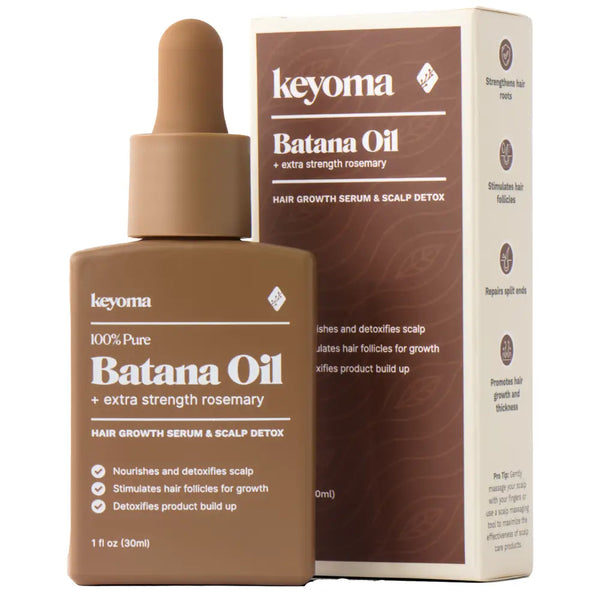
- 30-day supply $50
- 30% off for life $6
- Free haircare essentials kit $33
- Free custom wooden comb $10
- Free scalp massager $15
- Free eco-friendly travel bag $8



